Human Development Index: South Asia
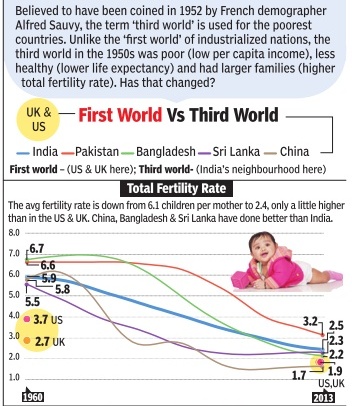
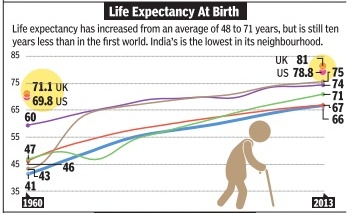
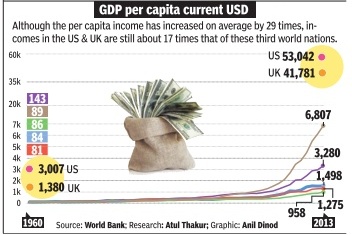
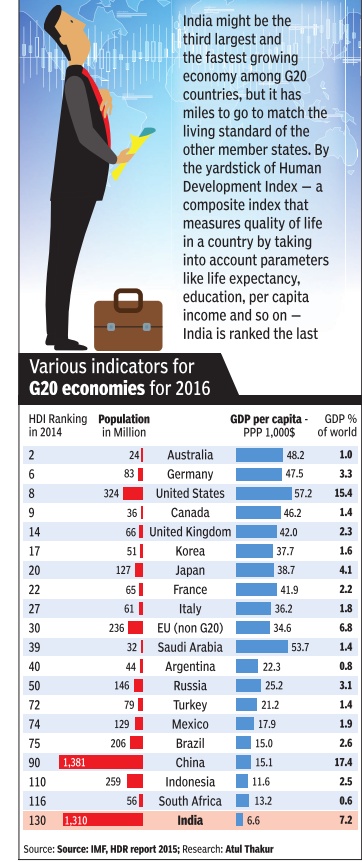
This is a collection of articles archived for the excellence of their content.
|
Contents |
Sources of this article
i) HDR.UNDP
ii) Life expectancy in India goes up by 7.9 years since 1990: UNDP report The Times of India TNN | Jul 24, 2014
iii) India ranks 135 in human development index: UNDP TNN | Jul 24, 2014 The Times of India
Countries and HDI ranks in 2013 and change in rank from 2012 to 2013
In the alphabetical order
|
Afghanistan |
169 |
0 |
|
Bangladesh |
142 |
1 |
|
Bhutan |
136 |
0 |
|
India |
135 |
0 |
|
Maldives |
103 |
0 |
|
Myanmar |
150 |
0 |
|
Pakistan |
146 |
0 |
|
Sri Lanka |
73 |
2 |
Listed by HDI rank
|
Sri Lanka |
73 |
2 |
|
Maldives |
103 |
0 |
|
India |
135 |
0 |
|
Bhutan |
136 |
0 |
|
Bangladesh |
142 |
1 |
|
Pakistan |
146 |
0 |
|
Myanmar |
150 |
0 |
|
Afghanistan |
169 |
0 |
South Asian countries in HDR 2014
India’s life expectancy has increased from 58.5 years in 1990 to 66.4 years in 2013.
India's human development index (HDI), a measure of health, education and standard of living, inched up by less than half a per cent between 2012 and 2013, the new Human Development Report 2014 says. While this slow growth is similar to most other countries, it is much below India's growth in the past. Between 1980 and 2013, India's HDI increased by nearly 59%, a yearly growth of about 1.4%. But since 2010, India's growth in human development measures has slowed down considerably.
India is ranked at 135, among the 'medium development' countries like Egypt, South Africa, Mongolia, Philippines and Indonesia. Among India's neighbours, Bhutan and Bangladesh too figure in this category. Pakistan (ranked 146) and Nepal (145) are in the 'low development' category, while Sri Lanka (73) is in the 'high development' category.
The HDR covers 187 countries across the world and is published annually by the United Nations Development Programme (UNDP). In the current report, the top five countries ranked in terms of the HDI are Norway, Australia, Switzerland, Netherlands and the US. The bottom five in this ranking are Niger, Democratic Republic of Congo, Central African Republic, Chad and Sierra Leone.
Citing recent estimates of giving universal basic old age and disability pension, basic childcare benefits universal healthcare, social assistance and 100-day employment guarantee, the report says India would need to spend just about 4% of its GDP to provide all this.
Life expectancy
India's life expectancy has increased from 58.5 years in 1990 to 66.4 years in 2013. While this is a significant increase, both Pakistan and Bangladesh have slightly better life expectancy. Among the BRICS countries, only South Africa has a lower expectancy at 56.9 years, primarily due to the HIV/AIDS epidemic. China's life expectancy is 75.3 years. The average for the whole world is 70.8 years, while among the developed countries with very high human development levels, it is 80.2 years.
Educational indicators
On educational indicators, India performs slightly better with 11.7 expected years of schooling, the same as the average for medium human development countries, of which India is a part. This is a measure of how many years of schooling a child is expected to receive if prevailing enrollment patterns continue. The world average is 12.2 years, while the developed countries average 16.3 years. Among the BRICS countries, India's average is the least. Currently, Indians of 25 years or more have received just 4.4 years of schooling on average, compared to a global average of 7.7 years.
Income
It is on the income measure that India fails dramatically. The annual income per person (measured in purchasing power parity terms) for India is $5,150, slightly more than our neighbors, but lowest among the BRICS countries, and less than half the global average of $13,723. The developed countries' average is way ahead at $40,046.
Inequality
To take into account inequality within a country, HDI 2014 also gives an 'inequality adjusted HDI' (IHDI) for 145 countries for which data was available. India lost about 29% in human development because of inequality. This loss was the most, about 42%, in education. Brazil too has a high loss of 26% due to inequality while Russia loses about 12%. China and South Africa did not have the requisite data for this. The world average for inequality loss is 23%.
Multi-dimensional poverty index (MPI)
Another measure is the multi-dimensional poverty index (MPI), which measures deprivations of families in education, health and standard of living using ten indicators. This gives a better picture of poverty than simply measuring incomes. According to this measure, over 55% of India's population is multi-dimensionally poor, compared to just 3% in Brazil, 6% in China and about 10% in South Africa. HDR 2014, however, has used 2005-06 data for India, which is quite outdated.
Gender inequality
Another measure is the gender inequality index (GII), which reflects inequalities in reproductive health, empowerment and economic activity. India is ranked 127 out of 152 countries in this, the same as Pakistan and lower than Bangladesh (115). Among the BRICS countries, India is the lowest. China is ranked best at 37, due to its very good women's health indicators and high female work participation (64%)
South Asian countries in HDR 2017
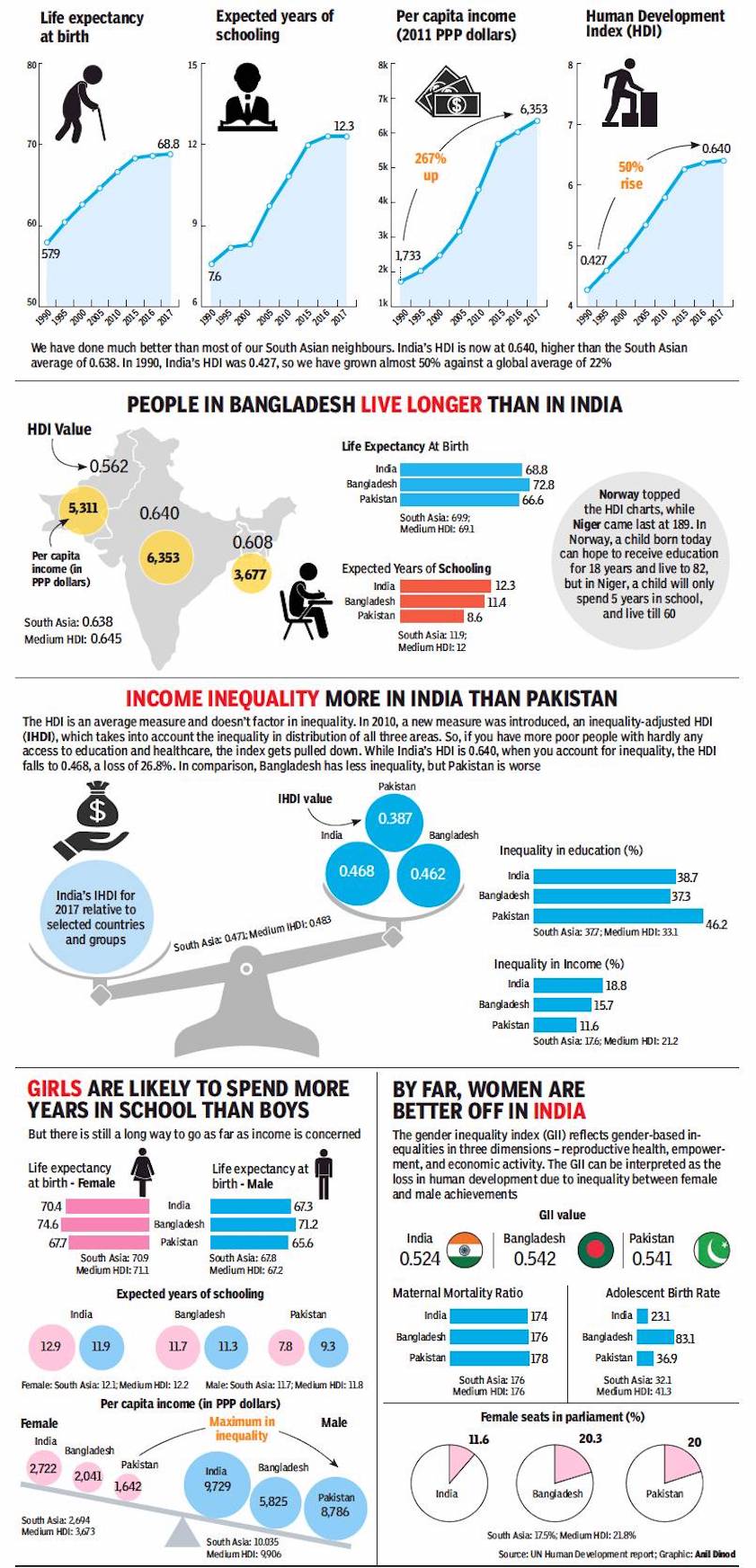
Life expectancy, school education, per capita income, and the Human Development Index
Income (in)equality
Women: Maternal mortality, seats in parliament, girls’ education
From: September 15, 2018: The Times of India
See graphic :
Human Development in Bangladesh, India and Pakistan in 2017
Life expectancy, school education, per capita income, and the Human Development Index
Income (in)equality
Women: Maternal mortality, seats in parliament, girls’ education
India went up one notch in the UN Human Development Index, ranking 130 out of 189 countries surveyed. But if you compare where India stands now with where we were in 1990, we have made massive progress. While Indians had a life expectancy of only 57.9 years in 1990, this has gone up to 68.8 years. Similarly, we are all a lot better off, with a per capita income of $6,353 (in PPP) in 2017 compared with only $1,733 in 1990. That’s a 267% growth
South Asian countries in HDR 2018
India ranks 129, up one spot
Ambika Pandit, Dec 10, 2019 Times of India
India finds itself ranked 129 out of 189 countries in the Human Development Index brought out by the UNDP as part of its Human Development Report 2019. While this is incremental improvement of one point from previous year’s rank of 130, India’s HDI from 1990 to 2018 shows a rise of 50% (0.431 to 0.647) with life expectancy at birth increasing by 11.6 years and Gross National Income per capita increasing by over 262% in this 28 year period. In terms of education, mean years of schooling increased by 3.5 years and expected years of schooling increased by 4.7% in the same period.
The overall HDI value places India above the average (0.634) for countries in the medium human development group and also above the average ( 0.642) for other south Asian countries. HDI has been calculated by assessing long-term progress on three dimensions of human development — a long and healthy life, access to knowledge and a decent standard of living.
However, the challenges are evident in the numbers. While highlighting that India has lifted 271 million out of poverty from 2005-06 to 2015-16, the Human Development Report also draws attention to the fact that 28% of the 1.3 billion multidimensional poor are in India.
Meanwhile, India’s improved HDI is attributed to “nearly three decades of rapid development, which has seen a dramatic reduction in absolute poverty, along with gains in life expectancy, education, and access to health care.” “India’s development initiatives like the Pradhan Mantri Jan Dhan Yojana and Ayushman Bharat are crucial in ensuring that we meet our promise to leave no one behind,” said Shoko Noda, UNDP India Resident Representative.
The report also focuses attention on the next generation of inequalities opening up, particularly around technology and the climate crisis.
South Asian countries in HDR 2019
December 17, 2020: The Times of India

From: December 17, 2020: The Times of India
India ranked 131 out of 189 countries in the UNDP’s Human Development Index (HDI) for 2019, down one step from rank 130 in the previous year. The just released Human Development Report 2020 showed that while India’s HDI score of 0.645 had inched up marginally from 0.642 in 2018, it was still lower than the average for developing countries of 0.689.
The HDI, which completes 30 years, seeks to present a composite measure of where countries stand on three broad fronts — health, education and economic well-being — using life expectancy, expected and mean years of schooling and per capita gross national income as proxies for these three.
In 2019, India ranked 133rd on life expectancy at birth, 125th on expected years of schooling, 162nd on mean years of schooling and 126th on GNI per capita, suggesting that its human development indicators are worse than mere economic factors would warrant.
The data in the report also shows that the improvement in India’s HDI score has been slowing down of late. Between 1990, when the HDI was first compiled, and 2000, India’s score improved by 1.44% a year on average. In the next decade, from 2000 to 2010, it did even better with an annual average improvement of 1.58%. Against this, the average rise of 1.21% a year between 2010 and 2019 was a clear slowdown.
Over the last couple of years, the improvement has been even slower, by 0.3% in 2018 and 0.5% in 2019. While improvements in scores are likely to slow down as the scores increase, India is hardly at a level where that should be happening, still being classified in the “medium human development category”. Norway continues to be at the top of the HDI rankings with Ireland, Switzerland, Hong Kong and Iceland rounding off the top 5. Germany, Sweden, Australia, the Netherlands and Denmark are the others in the top 10, an illustration of the extent to which Western Europe dominates the top of the list.